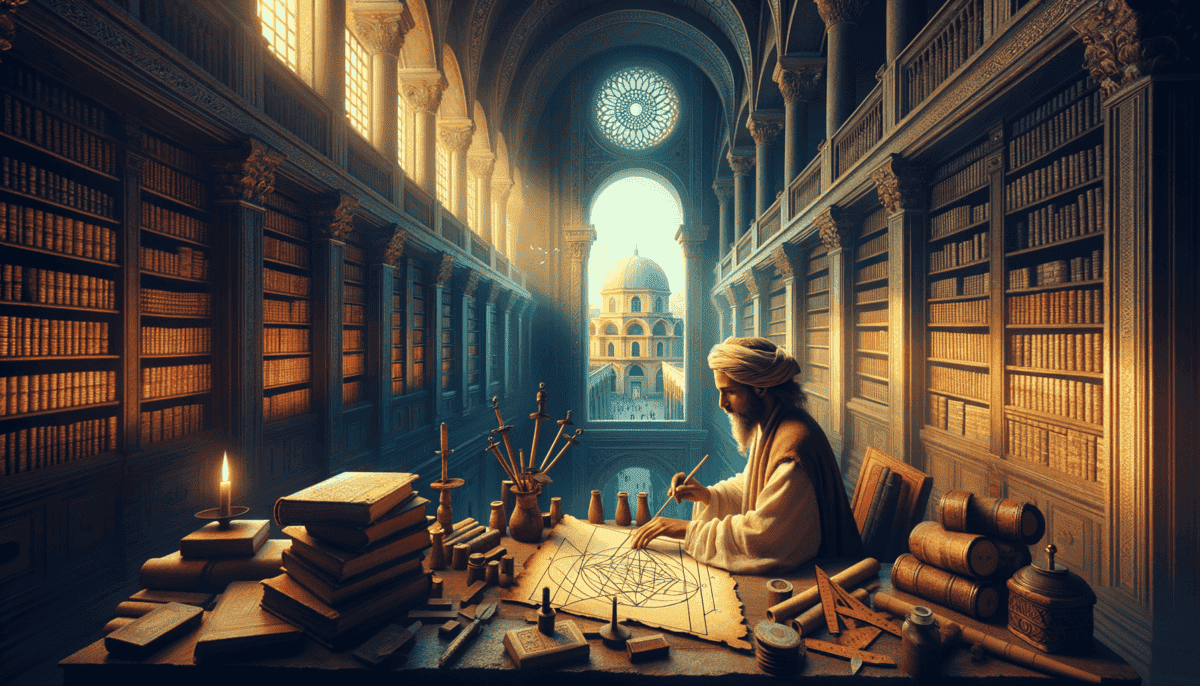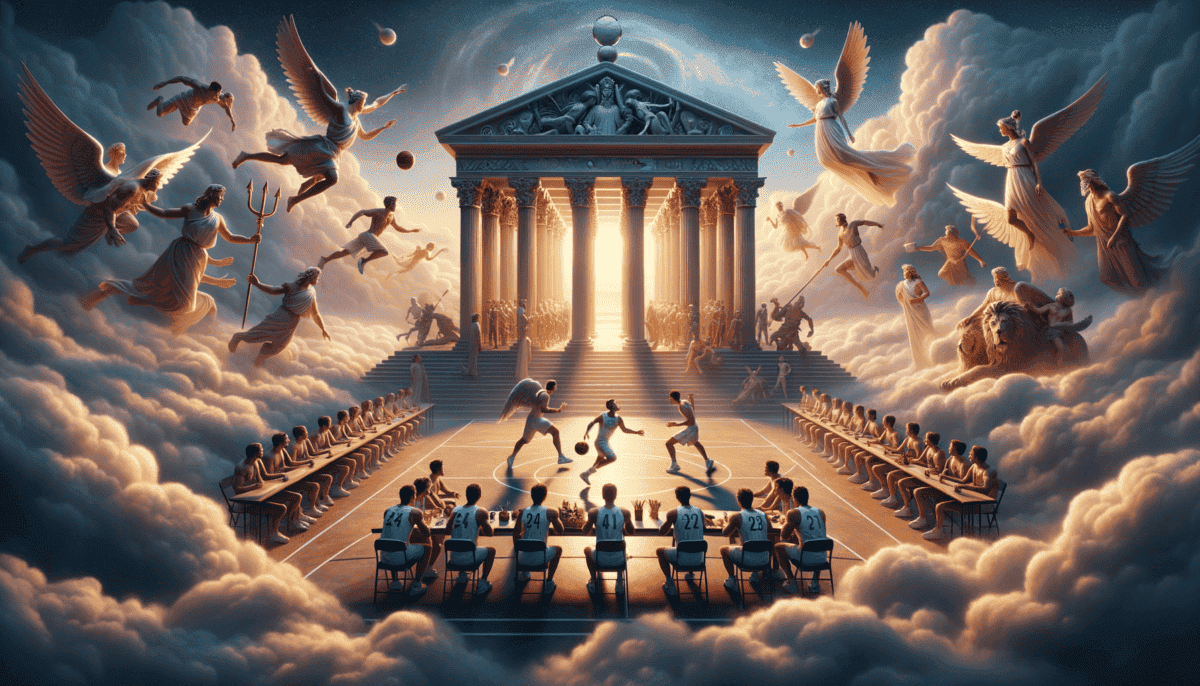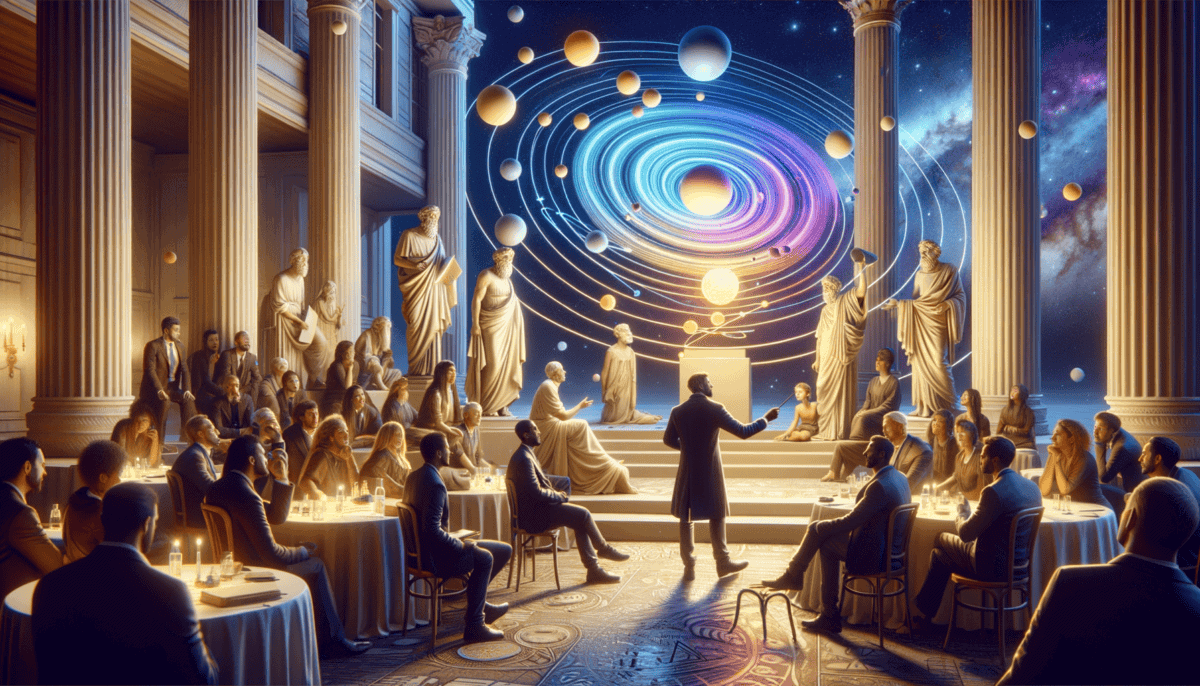The Curious Mind of Pythagoras
On a sunny morning in ancient Greece, young Pythagoras sat under an olive tree. He watched bees buzzing from flower to flower. The way they built their honeycomb caught his eye. Each cell was a perfect six-sided shape!
“Why do bees always make the same shapes?” he wondered aloud. His eyes sparkled with curiosity.
Little Pythagoras loved to count things. He counted the petals on flowers. He counted the stars at night. He even counted the steps from his house to the town square!
“Numbers are everywhere!” Pythagoras would tell his friends. “They’re in music, in nature, and in the shapes all around us.”
One day, while playing with pebbles on the beach, Pythagoras made an amazing discovery. He laid out the pebbles in different patterns:
- ⚪ One pebble made a dot
- ⚪⚪⚪ Three pebbles made a triangle
- ⚪⚪⚪⚪ Four pebbles made a square
As he grew older, Pythagoras started teaching others about numbers. He opened a special school where students learned about math and music. But his biggest discovery was still to come!
The Amazing Triangle Discovery
One day, Pythagoras was looking at a right triangle (a triangle with one square corner). He noticed something special about the squares you could draw on each side.
“Look!” he said to his students. “If you draw squares on all sides of this triangle, the two smaller squares add up to make the big square!”
This was huge! Nobody had ever noticed this before. Today, we call this the Pythagorean theorem. It helps people build houses, make maps, and even send rockets to space!
But not everyone liked new ideas in ancient Greece. Some people thought Pythagoras was silly for spending so much time with numbers.
“Why do we need to know about triangles?” they would ask.
Pythagoras just smiled and kept teaching. He knew that understanding numbers and shapes was important. He was right! His ideas still help people solve problems today.
What Pythagoras Taught Us:
✨ Numbers are everywhere in nature
✨ Shapes follow special rules
✨ Math can help us understand our world
Every time young Pythagoras made a new discovery, he felt like he was unlocking a secret about the world. He showed us that if we look carefully, we can find patterns and answers all around us.
As the sun set over the Greek hills, Pythagoras looked at his students with pride. He knew this was just the beginning of many amazing discoveries to come.
Euclid’s Geometric Quest
Inside the great Library of Alexandria, young Euclid’s eyes grew wide. Thousands of scrolls lined the walls, filled with knowledge from all over the world. But something was missing – there was no book that explained shapes in a way that made sense to everyone.
“I will write a book that helps everyone understand shapes,” Euclid decided. He picked up his writing tools and got to work.
First, Euclid started with simple things everyone could agree on:
- A straight line is the shortest path between two points
- A circle is round and all points are the same distance from the center
- Two parallel lines never meet
Then came the fun part! Euclid showed how these simple ideas could help solve bigger problems.
“If you know the simple things,” Euclid told his students, “you can figure out the hard things!”
Euclid’s Big Adventure
One day, a king asked Euclid to make geometry easier to learn. Euclid smiled and said, “There is no royal road to geometry.” This meant everyone had to learn step by step, even kings!
Euclid wrote everything down in a book called “Elements.” He used pictures and clear explanations to show how shapes work. It was like a big puzzle book for geometry!
Some people didn’t like Euclid’s new way of teaching:
“Why do we need to prove things we can see?” they asked.
“Because seeing isn’t always enough,” Euclid would answer. “We need to understand why things are true.”
Cool Things Euclid Taught:
✨ How to draw perfect shapes
✨ Why circles are special
✨ How to measure angles
Students came from all over to learn from Euclid. He showed them how to use a ruler and compass to draw perfect shapes. It was like magic, but with math! ✨
One of Euclid’s favorite things to teach was about triangles. He showed that the angles in any triangle always add up to 180 degrees. His students would measure different triangles to see if it was true – and it always was!
Fun Activity: Try drawing a triangle and measuring its angles with a protractor. They’ll always add up to 180 degrees, just like Euclid said!
As days turned into weeks, more and more people began to understand geometry thanks to Euclid’s clear explanations. His book became famous all around the world.
Even today, students learn geometry the way Euclid taught it. His ideas help architects build buildings, artists create beautiful designs, and scientists understand space! ️
At the end of each day, Euclid would look at his students drawing shapes and solving problems. He knew that by breaking down big ideas into small steps, anyone could learn about the amazing world of geometry.
Archimedes and the Golden Crown
In the beautiful city of Syracuse, young Archimedes loved to watch ships in the harbor. He always wondered how things worked. His favorite question was “Why?”
One day, King Hiero called for Archimedes. The king had a problem!
“Someone made me a crown,” said the king. “I gave them gold, but I think they mixed in cheaper metal. Can you help me find out?”
Archimedes scratched his head. He needed to check if the crown was pure gold without breaking it. This was tricky!
“I need time to think,” Archimedes told the king. “The answer will come to me!”
That evening, Archimedes went to take a bath. As he got in, water spilled over the sides. Suddenly, his eyes got big!
Archimedes’ Big Idea!
Different things push out different amounts of water when you put them in. Gold pushes out less water than cheaper metals do!
“EUREKA!” he shouted. (That means “I found it!” in Greek.) He was so excited, he ran through the streets in his bathtub clothes! ♂️
The Test of the Crown
Archimedes set up his test:
- Put the crown in water and measure the splash
- Put the same weight of pure gold in water
- Compare the splashes
The crown made a bigger splash than pure gold would. This meant it wasn’t pure gold! The king’s crown maker had been sneaky.
Archimedes’ Other Cool Inventions:
✨ A big claw that could lift ships out of the water
✨ A screw that could move water uphill
✨ Better ways to move heavy things
People started bringing Archimedes all sorts of problems to solve. He loved using science to help them!
“How can we lift heavy stones?” they asked.
“Give me a place to stand,” Archimedes said, “and I can lift the whole world!” He made special tools called levers that made lifting easier.
Try This: Use a ruler as a lever! Put it on a pencil and try to lift something light. That’s how Archimedes’ machines worked!
When enemies attacked Syracuse, Archimedes helped protect the city. He made giant mirrors to reflect sunlight at enemy ships. He built huge machines to throw rocks. His inventions kept the city safe! ️
Every day, Archimedes watched, wondered, and solved problems. He showed that science could help make life better. His ideas still help us today – in boats, buildings, and many machines!
The best part? It all started with a bath and a crown! Sometimes the biggest discoveries happen when we least expect them.
Looking to the Stars
On a clear night in ancient Greece, young Aristarchus looked up at the stars. He wondered why they moved across the sky every night. Everyone said Earth was the center of everything, but Aristarchus wasn’t so sure.
“Why does the sun look so big and bright?” he asked his teacher one day.
“Because it’s special,” the teacher said. “It moves around Earth just like all the stars.”
But Aristarchus had an amazing thought: “What if we’re wrong? What if Earth moves around the sun?”
“Sometimes the bravest thing we can do is question what everyone believes,” Aristarchus wrote in his diary.
A New Way of Seeing
Aristarchus spent many nights watching the sky. He noticed something interesting about shadows during the moon’s phases. This helped him figure out three big things:
- The sun is much bigger than Earth
- Earth spins around like a top
- Earth travels around the sun
Wow Fact! Aristarchus was right about the sun being bigger. It’s actually more than a million times bigger than Earth!
When Aristarchus shared his ideas, many people didn’t believe him.
“Earth can’t move!” they said. “We would feel it!”
“If Earth moved,” others laughed, “birds would be left behind in the sky!”
Try This Fun Test:
Jump up and down in a moving car or bus (when it’s safe!). You jump straight up and down, even though you’re moving forward. That’s how Earth works too!
But Aristarchus didn’t give up. He wrote books about his ideas and made careful measurements. He used math to show how the planets might move around the sun.
A Brave New Idea
“Look at the planets through this tube,” he would tell people. “See how they dance in the sky? There must be a reason!”
Amazing Truth: It took almost 2000 years before people realized Aristarchus was right! A scientist named Copernicus later proved that Earth really does move around the sun.
Even though most people didn’t believe him, Aristarchus kept studying the stars. He taught his students to question things and look for proof. He showed that it’s okay to think differently.
“The truth is like a star,” he would say. “Sometimes we can’t see it clearly, but it’s always there, waiting to be discovered.” ⭐
Remember: Being brave enough to think differently can lead to amazing discoveries! Just like Aristarchus, we should never be afraid to ask “What if?”
At night, when you look up at the stars, remember Aristarchus. He dared to imagine a whole new way of seeing our place in space. And he was right all along!
Building Better Ways to Learn
In a sunny courtyard in Athens, a group of young students gathered around their teacher, Theophrastus. They were trying something new – writing down their questions about nature in a special way.
“How can we be sure about what we learn?” asked Sofia, a curious student.
“By testing our ideas!” Theophrastus smiled. “Let me show you how.”
The Greek Way of Learning
Theophrastus drew a simple chart in the sand. “First, we ask a question. Then we guess what might happen. Finally, we test to see if we’re right!”
The Greek Learning Steps:
- Watch carefully
- ❓ Ask questions
- Make a guess
- Test your ideas
- Write down what happens
“Let’s try it!” said Sofia. “I wonder why leaves turn brown in fall?”
The class worked together. They collected leaves, watched them change, and wrote down everything they saw.
“When we work together and share what we learn, we can find better answers,” Theophrastus explained.
Fighting Old Stories with Facts
Many people believed in magic and myths to explain the world. But the Greeks found a better way.
Try This!
When you want to learn something new, use the Greek way:
1. Ask your question
2. Think about possible answers
3. Test your ideas
4. Share what you learn
“But what if we’re wrong?” asked another student.
“Being wrong is part of learning!” Theophrastus laughed. “We just try again with a new idea.”
Working Together to Learn More
The Greeks didn’t keep their ideas secret. They wrote them down and shared them with others.
Cool Discovery: Greek ideas about learning still help scientists today!
They built big libraries where people could study together. The biggest was in Alexandria, Egypt. It held thousands of scrolls full of ideas and discoveries.
“Knowledge grows when we share it,” Theophrastus would say. “Like planting seeds in a garden.”
Important: The Greeks taught us that anyone can be a scientist. All you need is curiosity and a way to test your ideas!
By working together and testing their ideas, the Greeks created new ways to learn about the world. Their methods helped people understand that nature follows rules we can discover.
A Legacy That Lives On
On a modern university campus, Professor Elena walks with her young students past a statue of Pythagoras. The ancient Greek thinker’s wise eyes seem to twinkle in the sunlight.
“Can you believe,” Elena says with a smile, “that the math we use today started with these amazing Greeks?”
Ideas That Changed Everything
“Look around,” Elena points to tall buildings nearby. “Architects use Pythagoras’s triangle math to make sure buildings stand strong. When you play basketball, you’re using angles like Euclid studied!”
Little Maria raises her hand. “Even in my video games?”
“Especially in video games! The computer uses Greek math to make everything move just right.”
“The Greeks gave us something special – they taught us how to think about problems in new ways,” Elena explains.
Greek Ideas We Still Use:
- ✨ Math for building things
- Ways to solve problems
- Writing down what we learn
- Testing our ideas
- Sharing knowledge with others
New Discoveries Every Day
The class walks into a modern science lab. Computers blink and screens show colorful patterns. But the spirit of Greek discovery is still alive here.
Did You Know? Scientists today ask questions just like the Greeks did. They work together to find answers, just like in ancient times!
“The Greeks started something wonderful,” Elena tells her students. “They showed us that anyone can be a scientist if they’re curious and work hard.”
Looking to the Future
As the sun sets, casting long shadows like the ones Archimedes once studied, Elena’s students buzz with excitement about their own future discoveries.
Your Turn! What will you discover? The Greeks showed us that big ideas can start with simple questions!
“Remember,” Elena says as class ends, “every time you ask ‘why?’ or ‘how?’, you’re following in the footsteps of these great thinkers.”
The ancient Greeks may be gone, but their love of learning lives on in labs, classrooms, and curious minds everywhere. Their greatest gift wasn’t just what they discovered – it was showing us how to discover things for ourselves.
The Adventure Continues: Every day, people around the world use Greek ideas to solve new problems and make amazing discoveries. What will YOU discover next?






